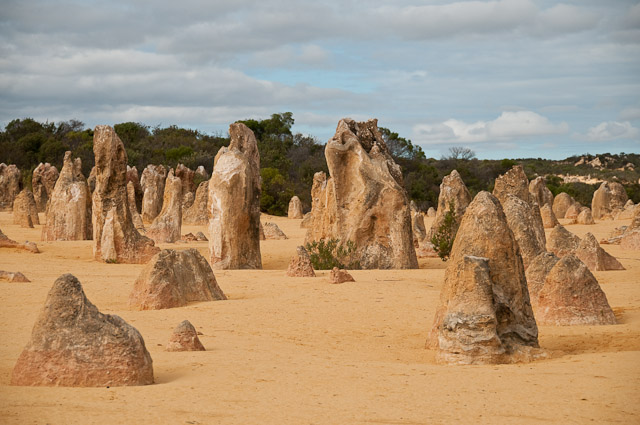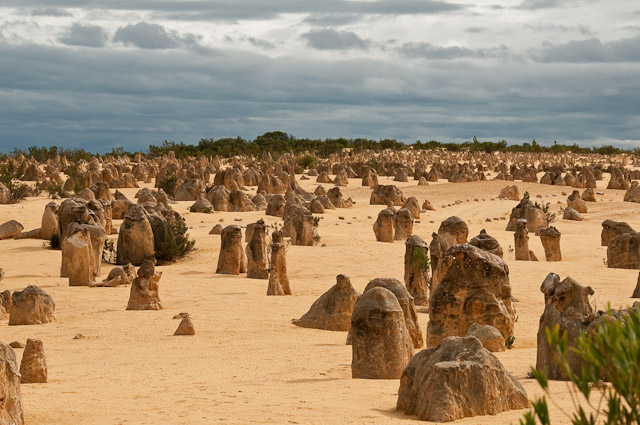PINNACLES - ENIGMAS IN STONE
In the Pinnacles Desert, right in the heart
of Nambung National Park, thousands of huge limestone pillars rise
out of a stark landscape of yellow sand. In places they reach up to
three and a half metres tall. Some are jagged, sharp-edged columns,
rising to a point, while others resemble tombstones.
They are part of the Tamala Limestone, the
geologically young formation of remnant sand hills that occurs over
an extensive part of the west coast. However the Pinnacles are
quite extraordinary and give rise to a unique and beautiful
landscape.
The Tamala Limestone is one of the most
recent deposits in the Perth Basin. It consists essentially of sand
dunes which have been cemented into hard limestone by rainwater
percolating through them and redepositing dissolved calcium
carbonate within the core of the dune to form limestone.
Just like today’s sand hills, these old
sand hills were covered in vegetation. The humus layer made the
rainwater slightly acidic and this dissolved calcium carbonate at
or near the surface. Roots of the larger plants provided conduits
for this water to percolate down and this resulted in redeposition
of the calcium carbonate around the (possibly dead) root system.
There is evidence that bushfires denuded the dunes allowing strong
winds, so prevalent in this area, to blow away the loose sand
leaving the columns of cemented calcium carbonate (limestone)
exposed.
However……..
“Despite their spectacular and
widespread occurrence in this region, little if any scientific
research has been dedicated to understanding how and when the
pinnacles formed. Nearly all geological aspects related to their
formation are controversial…”
- geologist Paul Hearty, 2006
and again……..
“…as sand hills are such a
common feature on our planet I find it curious that pinnacles are
so relatively rare. Perhaps the above explanation of their
formation has been oversimplified and some more unusual and subtle
process has taken place. The Pinnacles are an outstanding example
of this phenomenon and as such remain somewhat
enigmatic.”
- geologist Peter Lane, 2004

The Pinnacles Desert is accessed via Pinnacles
Drive and is approximately 17km SSE of Cervantes.
PLEASE
NOTE: Fees apply to enter Nambung National Park.
The Pinnacles Desert Discovery Centre is open daily
(for 7 hours) except on Christmas day. The park can be accessed
outside of these hours, with payment made during the day, but
overnight camping is not permitted.
Apart from visiting the Discovery Centre and
enjoying the view from the Pinnacles View Lookout (which are both
wheelchair accessible), you can walk through the Pinnacles Desert
on the Desert View Walk (a 1.2km loop) and/or drive through on a
4km one-way loop.

To log this cache you need to
A.
Answer the following questions:-
1. At the
entrance to the Pinnacles Desert Discovery Centre are some charred
posts with Aboriginal words inscribed on them. According to the
sign, what is the meaning of the words on the post closest to the
sign?
2.
According to the above theory of pinnacle formation, what was
it that caused the calcium carbonate near the surface to
dissolve?
3.
According to the sign at The Pinnacles View Lookout (at the
given co-ords), after pinnacles have been exposed by shifting
sands, what further process do they undergo?
B.
Post a photograph of your visit to the area (but please
don’t include any of the signs).
Please email your answers for part A to us so we
can give you the OK to claim a find, then you can log it and upload
your photo.